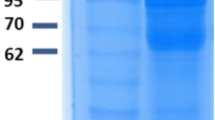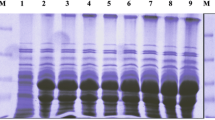Abstract
Vegetative insecticidal protein (Vip) is a class of insecticidal proteins produced by many Bacillus thuringiensis strains during their vegetative growth stage. The vip3LB gene of B. thuringiensis strain BUPM95, which encodes a protein active against the Lepidoptera olive tree pathogenic insect Prays oleae, was cloned into pET-14b vector and overexpressed in Escherichia coli. The expressed Vip3LB protein, found in the E. coli cytoplasmic fraction, was purified and used to produce anti-Vip3LB antibodies. Using the midgut extract of P. oleae, the purified Vip3LB bound to a 65-kDa protein, whereas Cry1Ac toxin bound to a 210-kDa midgut putative receptor. This result justifies the importance of the biological pest control agent Vip3LB that could be used as another alternative particularly in case of resistance to Cry toxins.





Similar content being viewed by others
Abbreviations
- B :
-
Bacillus
- P :
-
Prays
- IgG:
-
Immunoglobulin G
References
Höfte, H., & Whiteley, H. R. (1989). Insecticidal crystal proteins of Bacillus thuringiensis. Microbiological Reviews, 53, 242–255.
Tounsi, S., J’Mal, A., Zouari, N., & Jaoua, S. (1999). Cloning and nucleotide sequence of a novel cry1Aa-type gene from Bacillus thuringiensis subsp. kurstaki. Biotechnology Letters, 21, 771–775.
Tounsi, S., & Jaoua, S. (2003). Characterization of a novel cry2Aa-type gene from Bacillus thuringiensis subsp. kurstaki. Biotechnological Letters, 25, 1219–1223.
Estruch, J. J., Warren, G. W., Mullins, M. A., Nye, G. J., Craig, J. A., & Koziel, M. G. (1996). VIP3A, a novel Bacillus thuringiensis vegetative insecticidal protein with a wide spectrum of activities against lepidopteran insects. Proceedings of the National Academy of Sciences of the United States of America, 93, 5389–5394.
Warren, G. W. (1997). Vegetative insecticidal proteins: Novel proteins for control of corn pests. In N. B. Carozzi & M. Koziel (Eds.), Advances in insect control: The role of transgenic plants (pp. 109–121). London: Taylors & Francis.
Estruch, J. J., & Yu, C. G. (2001) Plant pest control. U.S. Patent 6,291,156 B1.
Mesrati, A. L., Tounsi, S., & Jaoua, S. (2005). Characterization of a novel vip3-type gene from Bacillus thuringiensis and evidence of its presence on a large plasmid. FEMS Microbiology Letters, 244, 353–358.
Chen, J. J., Yu, J. X., Tang, L. X., Tang, M. J., Shi, Y. X., & Pang, Y. (2003). Comparison of the expression of Bacillus thuringiensis full-length and N-terminally truncated vip3A gene in Escherichia coli. Journal of Applied Microbiology, 95, 310–316.
Mesrati, A. L., Karray, D. M., Tounsi, S., & Jaoua, S. (2005). Construction of a new high copy-number shuttle vector of Bacillus thuringiensis. Letters in Applied Microbiology, 41, 361–366.
Ferre, J., & Van Rie, J. (2002). Biochemistry and genetics of insect resistance to Bacillus thuringiensis. Annual Review of Entomology, 47, 501–533.
Schnepf, H. E., Crickmore, N., Van Rie, J., Lereclus, D., Baum, J., Feitelson, J., et al. (1998). Bacillus thuringiensis and its pesticidal crystal proteins. Microbiology and Molecular Biology Reviews, 62, 775–806.
Lee, M. K., Walters, F. S., Hart, H., Palekar, N., & Chen, J. S. (2003). The mode of action of the Bacillus thuringiensis Vegetative Insecticidal Protein VIP3A differs from that of Cry1Ab δ-endotoxin. Applied and Environmental Microbiology, 69, 4648–4657.
Tounsi, S., Dammak, M., Rebai, A., & Jaoua, S. (2005). Response of larval Ephestia kuehniella (Lepidoptera/Pyralidae) to individual Bacillus thuringiensis kurstaki toxins and toxin mixtures. Biological Control, 35, 27–31.
Rouis, S., Chakroun, M., Saadaoui, I., & Jaoua, S. (2007). Proteolysis, histopathological effects and immunohistopathological localization of delta-endotoxins of Bacillus thuringiensis subsp. kurstaki in the midgut of lepidopteran olive tree pathogenic insect Prays oleae. Molecular Biotechnology, 35, 141–148.
Yu, C. G., Mullins, M. A., Warren, G. W., Koziel, M. G., & Estruch, J. J. (1997). The Bacillus thuringiensis vegetative insecticidal protein VIP3A lyses midgut epithelial cells of susceptible insects. Applied and Environmental Microbiology, 63, 532–536.
Lee, M. K., Rajamohan, F., Gould, F., & Dean, D. H. (1995). Resistance to Bacillus thuringiensis Cry1A δ-endotoxins in a laboratory-selected Heliothis virescens strain is related to receptor alteration. Applied and Environmental Microbiology, 61, 3836–3842.
Jurat-Fuentes, J. L., Gould, F. L., & Adang, M. J. (2002). Altered glycosylation of 63- and 68-kilodalton microvillar proteins in Heliothis virescens correlates with reduced Cry1 toxin binding, decreased pore formation, and increased resistance to Bacillus thuringiensis Cry1 toxins. Applied and Environmental Microbiology, 68, 5711–5717.
Jurat-Fuentes, J. L., Gould, F. L., & Adang, M. J. (2003). Dual resistance to Bacillus thuringiensis Cry1Ac and Cry2Aa toxins in Heliothis virescens suggests multiple mechanisms of resistance. Applied and Environmental Microbiology, 69, 5898–5906.
Jurat-Fuentes, J. L., Gahan, L. J., Gould, F. L., Heckel, D. G., & Adang, M. J. (2004). The HevCaLP protein mediates binding specificity of the cry1A class of Bacillus thuringiensis toxins in Heliothis virescens. Biochemistry, 43, 14299–14305.
Gould, F. (1998). Sustainability of transgenic insecticidal cultivars: integrating pest genetics and ecology. Annual Review of Entomology, 43, 701–726.
Roush, R. T. (1998). Two-toxin strategies for management of insecticidal transgenic crops; can pyramiding succeed where pesticide mixtures have not? Philosophical Transactions of the Royal Society of London, Series B, Biological Sciences, 353, 1777–1786.
Acknowledgments
This work was supported by grants from the Ministry of Higher Education, Scientific Research and Technology. We thank the Institut de l’olivier de Sfax, Tunisia for providing us with P. oleae larvae. We wish to thank Pr. Jamil Jaoua, Head of the English Unit at the Sfax Faculty of Science for having proofread this paper.
Author information
Authors and Affiliations
Corresponding author
Rights and permissions
About this article
Cite this article
Abdelkefi-Mesrati, L., Rouis, S., Sellami, S. et al. Prays oleae Midgut Putative Receptor of Bacillus thuringiensis Vegetative Insecticidal Protein Vip3LB Differs from that of Cry1Ac Toxin. Mol Biotechnol 43, 15–19 (2009). https://doi.org/10.1007/s12033-009-9178-4
Received:
Accepted:
Published:
Issue Date:
DOI: https://doi.org/10.1007/s12033-009-9178-4




